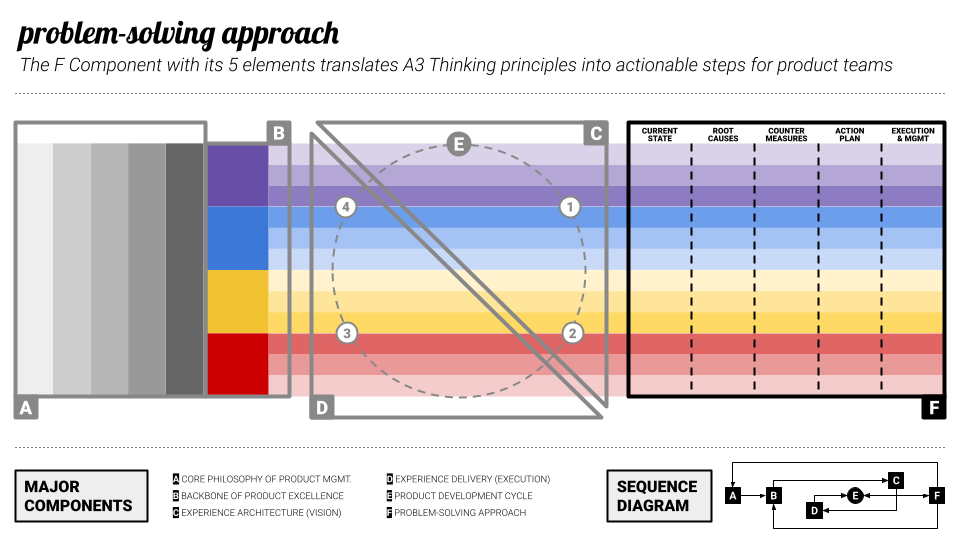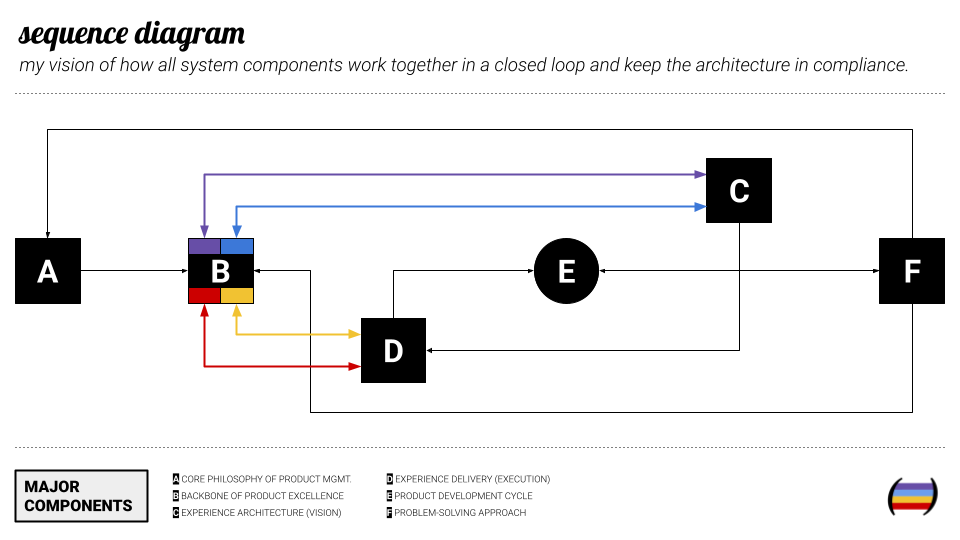Infusing Problem-Solving and Decision-Making (7/8)
The F Component: Why Problem-Solving Defines Product Excellence
Welcome back to my series on the Architecture for Product Excellence. This is the seventh installment, where I delve into the F Component, a fundamental part that shapes how we approach problem-solving and decision-making in product organizations. Through my experience leading teams in high-growth startups, I have observed that an organization's ability to systematically resolve problems is the key differentiator between average and exceptional product teams. More than merely arriving at solutions, excellence lies in reframing how we perceive and engage with problems.
The F Component draws significant inspiration from A3 Thinking, a structured problem-solving methodology originating in lean manufacturing. However, my intent is not to advocate for its rote adoption but rather to explore why structured analytical thinking is indispensable for product organizations, how it influences company culture, and how its application differs between early-stage startups and scaleups.
This isn't just about process or documentation. It's about fostering a way of thinking and acting that can transform how a product function operates toward excellence.
Core Principles of A3 Thinking
To understand the F Component, it's important to first grasp the problem-solving philosophy that underpins it. A3 Thinking, a Lean methodology rooted in Toyota's management system, has evolved into a transformative approach for startups navigating the chaos of early-stage growth and the complexities of scaling. By combining structured problem-solving with collaborative leadership, it offers a roadmap for aligning teams, driving data-driven decisions, and fostering resilience in high-stakes environments.
At its foundation, A3 Thinking revolves around four universal truths:
Scientific Problem-Solving: Built on the Plan-Do-Check-Act (PDCA) cycle, it emphasizes iterative learning over guesswork. Teams formulate hypotheses, test them empirically, and refine solutions based on evidence.
Root Cause Analysis: Tools like the "5 Whys" and fishbone diagrams drive teams to dig beyond symptoms (e.g., "Why did user retention drop?") to systemic issues (e.g., poor onboarding workflows).
Visual Storytelling: Condensing problems, data, and action plans onto a single A3-size sheet fosters clarity. For startups, this eliminates ambiguity in fast-paced settings.
Collaborative Ownership: Unlike top-down decision-making, A3 encourages cross-functional dialogue. Leaders mentor teams by asking questions rather than dictating answers—a critical skill for scaling.
This approach directly influences how product organizations diagnose problems, set priorities, and drive meaningful change. The F Component builds on these principles, providing a structured way to apply them in real-world product environments.
F Component Elements: A Comprehensive Breakdown
To fully grasp the impact of the F Component, it's crucial to break it down into its key elements. Each plays a distinct role in ensuring structured and effective problem-solving within a product organization. While A3 Thinking provides the foundation, these elements translate its principles into actionable steps for product teams.
After framing the context, urgency, and boundaries of the problem, you need to objectively map the current state and proceed to develop and implement a solution.
CURRENT STATE: Understanding the Present Situation This step involves thoroughly investigating the current situation and gathering information from various sources. It includes:
Gathering and Understanding Data: This means collecting relevant data from different sources (both internal and external) and synthesizing it to see the complete picture.
Identifying Key Metrics: We need to find and track the important indicators that reveal our current status. These could relate to financial performance, operations, or customer satisfaction—depending on the focus area.
Understanding Constraints: We must identify and comprehend any limitations that could affect outcomes. These could be internal (such as resource or budget constraints) or external (such as regulations or market conditions).
ROOT CAUSES: Root Cause Analysis (RCA) is a problem-solving methodology that goes beyond addressing surface issues. It delves deeper to identify the fundamental reasons behind problems. By understanding root causes, companies can develop effective solutions that prevent recurrence. RCA employs various techniques to investigate and determine underlying causes. The "5 Whys" technique involves repeatedly asking "Why?" to move past surface-level issues and identify core problems. Another valuable tool is the fishbone diagram (also known as the Ishikawa or cause-and-effect diagram), which visually maps potential causes and their relationships to the problem.
COUNTERMEASURES: Establishing a vision for success and identifying concrete interventions to bridge the gap between current and ideal states. At this point, you need to have a clear vision of what success looks like to prioritize potential countermeasures that will address the gaps.
ACTION PLAN: Defining a structured approach to execution, detailing responsibilities, milestones, and measurable outcomes. An Action Plan is essentially a comprehensive strategy to reach your ideal state by selecting and sequencing countermeasures. It typically includes:
Incremental Steps: Breaking down your major goal into smaller, manageable tasks.
Role Assignment: Determining who is responsible for each task to ensure clear accountability.
Checkpoints: Establishing milestones to monitor progress and maintain schedule adherence.
Success Metrics: Determining how to measure success and track progress.
Contingency Planning: Anticipating potential obstacles and developing backup plans.
Resource Allocation: Securing necessary personnel, funding, and tools for implementation.
Timeline: Creating a realistic schedule with deadlines for each phase.
Communication Strategy: Developing a plan for regular updates and stakeholder communication.
EXECUTION & MANAGEMENT: Ensuring accountability, tracking progress, and iterating based on real-world feedback to refine the solution over time. Monitor implementation, identify issues early, and adjust as needed.
By integrating these five elements, organizations create a repeatable, scalable decision-making framework, ensuring that product challenges are tackled systematically rather than reactively.
How the F Component Fits Into the Architecture for Product Excellence
Previous discussions in this series have examined the essential elements of Product Excellence, from foundational principles to execution and delivery. The F Component serves as the cognitive infrastructure that enables the entire system to function optimally. Its integration provides several critical advantages:
Enhancing Decision-Making at All Levels: Without a systematic approach to problem-solving, even the most well-conceived strategies risk fragmentation and inefficiency.
Mitigating Short-Term, Reactionary Thinking: Organizations lacking a structured problem-solving ethos often find themselves in perpetual crisis mode, applying superficial fixes that fail to address underlying causes.
Cultivating a Culture of Learning and Iteration: Embedding structured problem-solving into daily operations fosters a shared mental model, enhancing team collaboration and accelerating innovation.
Revealing Product Function Health: By identifying problems against the backdrop of product excellence architecture, you create a heatmap representing the structure's health and potential strengthening points.
Maintaining Architectural Component Compliance: To solve problems in the product function, you must reference inputs from other components, making it straightforward to audit missing elements within the complete operating system.
Rather than viewing problem-solving as an isolated competency, high-performing product organizations integrate it into their core cultural fabric, ensuring that strategic thinking permeates all decision-making processes.
Execution alone does not guarantee success. Great execution demands rigorous problem-solving.
The Cognitive Core of Problem-Solving in Product Organizations
Product development within high-growth environments is characterized by inherent complexity and ambiguity. Problems rarely present themselves in clearly defined terms; instead, they emerge as intricate entanglements of customer pain points, business constraints, technical limitations, and organizational dynamics. In response, teams often fall into two counterproductive extremes: reactive problem-solving (hastily applying superficial solutions) or analysis paralysis (overanalyzing issues without executing meaningful change).
The F Component offers a disciplined framework to escape this cycle. It encourages teams to pause just long enough to diagnose root causes and make deliberate, high-leverage decisions. Contrary to intuition, slowing down does not equate to inefficiency. Instead, deliberate reflection optimizes velocity by preventing redundant efforts and future disruptions.
While many startups perceive speed as their primary advantage, speed without strategic clarity leads to wasted motion. The most successful product organizations are not necessarily the fastest movers; they are the fastest learners. Structured problem-solving serves as the engine of this accelerated learning process.
The Mindset Shift: Problems as Strategic Leverage
A fundamental mindset shift for product leaders involves reconceptualizing problems as strategic assets rather than operational hindrances. Every challenge presents an opportunity to create competitive differentiation… if approached through the right lens.
Consider a startup grappling with customer retention challenges. A reactive team might implement a series of disconnected interventions—tweaking onboarding flows, deploying tooltips, launching retention-focused email campaigns—without fully understanding the underlying issue. Conversely, a team rooted in structured problem-solving would begin with fundamental diagnostic questions:
Is this a product-market fit issue, or does it stem from a deficiency in engagement mechanisms?
Are retention challenges uniform across customer segments, or are specific cohorts more affected?
What behavioral patterns correlate with long-term retention, and why are users failing to reach those pivotal moments?
By adopting a wide-lens diagnostic approach before diving into tactical execution, structured teams avoid surface-level fixes and instead redesign systemic conditions to drive sustainable retention.
This exemplifies how problem-solving evolves into a strategic lever and requires support from all components of the architecture for product excellence. When effectively institutionalized, it shifts team dynamics from subjective decision-making to data-informed, insight-driven action. It fosters an organizational ethos where challenges catalyze learning rather than trigger reactivity, ensuring that every problem-solving initiative contributes to long-term product excellence.
The Divergence of Problem-Solving in Early-Stage Startups vs. Scaleups
While structured problem-solving benefits all organizations, its application varies significantly between early-stage startups and scaleups.
Early-Stage Startups: Navigating the Unknown
The primary challenge for early-stage startups is identifying what to build and why. Problems at this stage are fluid, ambiguous, and often lack historical precedent. Here, structured problem-solving must prioritize hypothesis-driven learning over optimization.
Embrace Uncertainty: Decision-making often lacks robust data; thus, rapid experimentation becomes the primary tool for validating assumptions.
Prioritize Qualitative Insights: In the absence of extensive datasets, direct user interactions, observational research, and rapid prototyping offer more actionable guidance than numerical analytics alone.
Avoid Premature Optimization: Many early-stage teams overengineer processes before validating problem-solution fit. The primary focus should be iteration and learning, not perfection.
Scaleups: Managing Complexity at Scale
In scaleups, the problem landscape evolves. The focus shifts from proving a concept to ensuring repeatability and scalability. At this stage, structured problem-solving must transition from exploratory learning to systematic execution.
Standardizing Decision-Making: As teams expand, enforcing a common problem-solving framework minimizes misalignment and enhances operational coherence.
Balancing Speed with Systemic Rigor: Unlike early-stage startups, where rapid iteration is paramount, scaleups must safeguard against the unintended consequences of hasty decision-making.
Leveraging Data-Rich Environments: Unlike startups that operate with sparse data, scaleups must structure decision-making processes to extract actionable insights from vast datasets without succumbing to analysis paralysis.
The fundamental distinction? Early-stage startups leverage structured problem-solving for exploration, while scaleups use it for scalable efficiency. The underlying mindset remains unchanged, but its execution adapts to the organization's evolving maturity.
Why This Mindset Works
When leading a startup or managing a product in a high-growth environment, problems often emerge unexpectedly. The pressure to make quick decisions can push us toward overly simplistic solutions or those misaligned with broader strategy. This is where the F Component makes a difference.
Building Resilience and Agility: In the dynamic world of startups, agility is essential. However, agility without structure can lead to chaos. By applying the F Component, you can maintain agility while ensuring that every decision rests on careful thought and analysis. Teams can move from reactionary measures to proactive, strategic problem-solving simply by adopting a structured process.
Avoiding the Quick-Fix Trap: Quick fixes often lead to recurring problems. The F Component encourages us to look beyond the obvious and ask, "Why is this happening?" It drives us to identify root causes rather than just addressing symptoms. This deeper understanding helps create lasting solutions.
Aligning the Team: One of the biggest challenges in a startup is maintaining alignment. With the F Component, you create a common language and framework that everyone can understand. This shared approach to problem-solving and decision-making fosters better communication and collaboration. It becomes easier for the entire team—from engineers to marketers—to understand the rationale behind decisions, which builds trust and collective ownership of outcomes.
How LLMs Are Transforming Problem-Solving: Opportunities and Challenges in Product Management
The rise of Generative AI and Large Language Models (LLMs) is reshaping how product teams analyze problems, extract insights, and make decisions. However, LLMs complement rather than replace structured problem-solving frameworks like the F Component—they act as accelerators that enhance human-driven analysis when used strategically.
AI as an Augmenter of Human Judgment, Not a Replacement
While LLMs can process massive amounts of data, identify correlations, and generate hypotheses, they cannot inherently understand context, organizational constraints, or strategic nuances. Critical thinking, first-principles reasoning, and human intuition remain irreplaceable in high-stakes decision-making.
For example, an LLM might analyze user churn data and suggest that "reducing onboarding friction by 20% will improve retention." However, without deeper inquiry (e.g., what behavioral triggers actually drive long-term engagement?), teams risk implementing superficial fixes that do not address the root cause. Thus, LLMs should assist in hypothesis generation, but validation and execution require human oversight.
Speeding Up Root Cause Analysis with AI-Driven Insights
One of the most challenging aspects of problem-solving is moving past surface-level symptoms to uncover true root causes. LLMs can help by:
Synthesizing qualitative user feedback from surveys, support tickets, and app store reviews to identify common pain points
Detecting behavioral patterns in large datasets that might take human analysts weeks to recognize
Suggesting potential "5 Whys" breakdowns based on historical cases, allowing teams to challenge assumptions more effectively
However, teams must validate AI-generated insights through critical scrutiny and cross-functional alignment before driving product decisions.
Democratizing Access to Problem-Solving Best Practices
LLMs can serve as an on-demand knowledge repository, helping teams apply structured methodologies (like A3 Thinking, PDCA cycles, or the F Component) more consistently. This proves especially valuable in fast-scaling startups, where knowledge gaps often emerge.
For example:
Instead of a PM or Data Scientist manually guiding a team through Root Cause Analysis, an LLM-powered tool could generate customized diagnostic workflows based on past incidents
LLMs can provide context-aware recommendations, suggesting problem-solving techniques based on industry best practices and previous internal cases
This approach reduces cognitive load for teams, ensuring that structured problem-solving becomes second nature—even for less experienced product managers.
Avoiding Over-Reliance on AI-Generated Decisions
One of the biggest risks of AI-powered problem-solving is excessive dependence on algorithmic recommendations without deep understanding. LLMs, while powerful, cannot distinguish correlation from causation—they recognize patterns but lack reasoning abilities.
This is where human judgment becomes irreplaceable. AI serves as a tool, not a decision-maker—teams must interpret its outputs through a strategic lens to ensure that problem-solving remains insight-driven, not merely data-driven.
The Future: AI-Augmented Problem-Solving as a Competitive Advantage
The most successful product organizations will not be those that blindly automate decision-making, but those that intelligently integrate AI into structured problem-solving frameworks.
By embedding GenAI-enhanced problem-solving into their culture, product teams can increase clarity, reduce noise, and drive faster, more effective decision-making—without sacrificing the human intuition that distinguishes great products from merely functional ones.
Escalating the Right Problems: When to Involve Leadership
Not all decisions require the Chief Product Officer's (CPO) input, yet many product teams instinctively push challenges upward, assuming leadership must resolve them. This creates a bottleneck that slows execution and undermines team autonomy.
The F Component provides a framework for clarifying what truly requires top-level involvement and what teams should handle independently. It shifts the mindset from "Who makes the decision?" to "How do we ensure the right decisions are made at the right level?"
A well-structured approach to problem-solving means that:
Leaders focus on high-leverage decisions—those that impact strategy, long-term direction, or cross-functional alignment
Teams develop problem-solving autonomy, equipping themselves with tools to diagnose and address issues effectively
Escalation becomes intentional, not habitual—problems that reach the CPO are those that truly require their unique perspective or authority
Organizations that master this balance build scalable decision-making cultures, where leadership acts as an enabler rather than a bottleneck. Instead of solving every problem, they cultivate a problem-solving ethos at every level.
From Problem-Solving to Organizational Mastery
At its core, the F Component extends beyond problem resolution—it establishes the foundation for an organizational culture rooted in continuous learning and systematic refinement. It fosters a product environment where decisions are intentional, insights drive action, and every challenge serves as a catalyst for advancement.
For product leaders in high-growth environments, consider reflecting on these questions:
Is our organization reactive in its problem-solving, or are we fostering a learning-driven approach?
Do we possess a shared cognitive framework for decision-making, or does problem-solving vary arbitrarily across teams?
Are we addressing symptoms, or are we diagnosing and rectifying root causes?
The answers to these questions will determine whether your organization builds a resilient, high-caliber product function—or merely one that operates at high velocity without sustained impact.
I invite you to share your perspectives and thank you for joining me on this deep dive into the F Component, the last piece of my architecture. I look forward to continuing our journey toward product excellence together. In the next post, I will conclude the series by exploring the Sequence Diagram as my vision of how all system components work together in a closed loop.
Meanwhile, if you have questions or want to share your experiences, please comment below or reach out directly.





